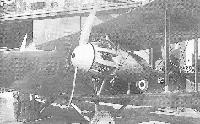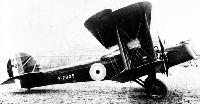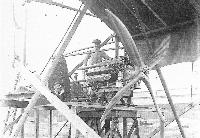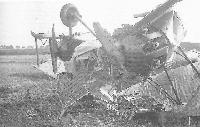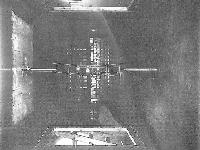
Описание
Страна: Великобритания
Год: 1918
Twin-engine, three-crew, three-bay biplane close-support light bomber
A.Brew Boulton Paul Aircraft since 1915 (Putnam)
P.7 Bourges
During 1918 John North began work on a twin-engined day-bomber to the official Specification A.2(b) which called for a twin-engined reconnaissance bomber. The design received the project number P.7. With the formation of the RAF a new list of specifications was issued, and the P.7 was aimed at three of them, No.IV, (Long-distance photographic-reconnaissance fighter), No. VI (Short-distance day bomber), and No.VIII, (Long-distance day bomber). The company referred to it as a Fighter-Bomber, however.
Three prototypes were ordered, each of which was to differ in some details. They were each three-seat, three-bay aircraft with unstaggered wings, and a spruce frame. They were fabric covered with the standard PC10 khaki-green finish on upper and side surfaces, with clear-varnished linen on the underside. The P.7 was in competition with the Avro Type 533 Manchester, a development of the earlier Types 523 Pike and 529, and the Sopwith Cobham triplane.
The Air Ministry had decided that all twin-engined landplanes with an all-up weight of less than 11,000 lb were to be named after inland towns of England and Wales (Seaplanes being named after coastal towns); and Boulton & Paul also still had to use the initial letters BO. For some reason the company chose a French town, Bourges, as the name for the P.7, but this was in keeping with Airco, who chose Amiens for their D.H.10, and Vickers who chose the name Vimy. The name did not find favour with the workforce who tended to call it the 'Burgess' or the 'Boanerges'.
The crew consisted of two gunners in nose and dorsal positions, and a pilot seated in front of the wings. The pilot's position was slightly raised compared with that of the nose gunner, and he was provided with a large windscreen. The nose gunner's Scarff ring was canted forward and fitted with a trunnion device to carry two .303 in Lewis guns. There was transparent panelling in the nose and a sliding panel beneath the nose for bomb aiming. The front gunner acted as bomb-aimer, being equipped with a bombsight, and release gear. The pilot was also able to release the bombs in an emergency. The dorsal gun position was also equipped with twin guns, and the Scarff ring was recessed below the fuselage top-line.
To fulfil the aircraft's role as a reconnaissance bomber, a large camera position was located just in front of the dorsal gunner's position, the gunner operating the camera, with provision for a case of spare plates. Provision was also made for fitting a transmitting/receiving radio.
The first Bourges, F2903, was supposed to be fitted with ABC Dragonfly engines, and as such was designated the Mk 1A. The Dragonfly engines were late in coming, and they suffered horrendous development problems. Designed by Granville Bradshaw they were the first high-power radial engines. Unfortunately they suffered from tremendous vibration and especially cooling problems, the cylinders running a dull red after a few minutes. Their normal power was 320 hp, but this fell away considerably after a little running time. The Bourges was one of many aircraft to suffer from having been designed to take them, another being the rival Avro Manchester.
To enable flight trials to start Bentley B.R.2 rotary engines of 230 hp were fitted to F2903, and it was redesignated Bourges Mk IIA in this form. The letter 'A' denoted the fact that the upper wing was carried straight above the fuselage on conventional struts, the letter 'B' being reserved for a different layout with the upper wing inboard of the engines being of gull configuration, sloping down to join the fuselage, to give all crew members a better all-round view, and the dorsal gunner a better field of fire.
The fuselage was a straightforward wire-braced box-section, with slab sides. The horizontal tail was built into the upper surface of the rear fuselage, and was supported by two struts above each side, connected to the fin, which possessed pleasingly curved lines.
The B.R.2s were set midway between the wings at the inner bay struts, and were eventually replaced by Dragonflies in a closely-cowled arrangement with large spinners and two-blade propellers. The cooling problems of the Dragonfly led to the spinners soon being discarded and the cowlings redesigned with a curved frontal section. Early flight trials had also led to the introduction of large horn balances on the four cable-connected ailerons, which increased the span from 54 ft to 57 ft 4 in.
The undercarriage had a very wide-track, the single mainwheels being carried on V struts directly beneath the engines with a bracing strut running to the underside of the fuselage.
The all-up weight was 6,300 lb, with a fuel capacity of 190 gallons and an internal bombload of 900 lb. The bomb-bay was between the lower spars and the shutter-opening bomb doors were operated by a system of laths and tensioned cords.
Top speed was 124 mph at 10,000 ft, and that height could be reached in only 11 minutes. The landing speed was only 50 mph. The Bourges proved to be capable of being rolled, spun and looped with ease, and in the hands of the usual Boulton & Paul test pilot, Frank Courtney, it astonished the crowds at its first public outing at Hendon in 1919, at the reception for Commander Read and the transatlantic NC-4 flying-boat.
The handling of the Bourges was delightful, and by shutting down one engine, Courtney was able to emulate the gyroscopic effect of the rotary in the Sopwith Camel, making up for the larger dimensions and greater inertia of the Bourges. Charlie Brown, the mechanic on the Bourges was quite happy to lean casually out of the front gunner's cockpit of the aircraft while Courtney was rolling or looping it!
Despite the excellent performance of the Bourges no production orders were forthcoming. They were under discussion at the end of the War, but the Armistice brought an end to them, and the RAF used the D.H.10 which was just coming into service. But for the delays caused by the Dragonfly engines, the Bourges might have secured large contracts before the War's end. After the end of the War Boulton & Paul made strenuous attempts to sell the aircraft around the world, but were not helped by the attitude of the Air Ministry. The company wanted to display the Bourges at the Amsterdam Aviation Exhibition and the Paris Air Show of 1919, but were refused permission to do so by the Air Ministry. The situation must have been very frustrating for John North and the board of directors, though in truth it is unlikely that any sales would have been forthcoming.
The rival Avro Manchester also only flew in prototype form, initially with Siddeley Pumas instead of the Dragonflies, and it was not before December 1919 that the Manchester received its Dragonflies. Because of its larger dimensions the Manchester had a slightly inferior performance to the Bourges, and was not nearly so manoeuvrable.
The other competing aircraft the Sopwith Cobham triplane was unique in being the only Sopwith/Hawker twin-engined aircraft ever built. Like the others it was designed for the ABC engine, but it first flew with Pumas, until the Dragonflies finally arrived. Its development made leisurely progress after the end of the War and it did not even go through its trials until the spring of 1920.
The second prototype Bourges, F2904, was the Mk 1B, and apart from differing because of the sloping inboard upper-wing sections, also had the Dragonflies installed on the lower wing, rather than at mid-gap. Work at Farnborough with a D.H.10 in which the engine positions were varied had shown, against all expectations, that placing the engines in the mid-gap position caused higher drag than if they were placed on the lower wing. Work on the first Bourges had been too advanced to change the engine arrangement, but the opportunity was taken to do so with the second prototype.
The engines were mounted inboard of the inner wing-struts, so that the undercarriage struts had to be slightly lengthened, to give the propellers the necessary clearance. The tail also differed, the rudder being increased in area, and the fin reduced, and a large dihedral angle was given to the tailplane to match the angle of the sloping section of the wing.
A new bomb-release system was also introduced. Stowage for three bomb supporting beams was arranged between vertical guides and supported by quick-pitch screws geared to a common horizontal shaft. When this was free to rotate each bomb came in turn to the discharge position, then left the screws and moved down laterally between oblique guides, and out of the way of the next beam and bomb. There were three bomb cells with shutter doors.
A complete bomb-loading system was also devised for the Bourges. The bomb cell was hoisted into position by gear attached to the upper longerons and could be removed before flight.
The third and last Bourges, F2905, was designated P.7B, and first flew in December 1920. It had the straight upper wing of the Mk 1A, but was fitted with 450 hp water-cooled Napier Lion engines on the lower wing. The mainwheels were moved slightly outboard of the engines. The engines had frontal radiators and drove four-blade propellers, giving the aircraft a top speed of 130 mph at 10,000 ft, up from 124 mph with the Dragonflies. This was a very high speed for a bomber, and coupled with the exceptional manoeuvrability of the aircraft, meant it was sometimes categorised as a fighter/bomber, and was claimed to be the fastest twin-engined aircraft in the world.
On this aircraft revised gun mountings, designed for lightness, were fitted. They could take one or two Lewis guns and had padded stocks to help prevent the gunners receiving bruises as they pressed against them with their shoulders to help traversing.
With a relatively short wing-span and small overall dimensions. the light wing-loading of only 8 lb/sq ft. gave the Bourges almost single-seat fighter-like agility, and yet it had an endurance of 9 1/4 hours, and could carry a significant bomb-load. A projected Mk III version of the Bourges, fitted with 290 hp Siddeley Puma engines was never built.
F2905 was delivered to Martlesham Heath in March 1921 with 3 hr 49 min flying time. A further 5 hr were flown, most of them involving its full range of aerobatic manoeuvres, then serious failures occurred to some of the wing fittings. The top rear centre section strut was badly bent, the fitting plate attaching it to the rear spar with bolts being distorted. The front spar fittings were also deflected, but not as much. Several other fittings in adjoining bays of the top plane also showed signs of deflections. It was considered that the upper wing was moving back during a loop.
As the aircraft was due to fly at the RAF Pageant urgent modifications were made. Oblique struts were fitted from the top longerons to the rear spar of the centre section, and further oblique struts in the bay comprising the gunner's cockpit.
After a further 1 hr and 20 min flying which included aerobatics in practice for the Pageant and the actual display itself, further failures occurred, but not as badly as before. It was considered that the entire wing system was moving relative to the fuselage during violent manoeuvres. These failures show that the impressive aerobatic performance of the Bourges was undertaken right on the edge of the limits of the aircraft's stressing. After the second failures further strengthening was instituted to the plates, and the anti-drag wires were doubled.
As late as 1923 F2905, by then entered on the civil register as G-EAWS, was still thrilling the crowds at the RAF Pageant at Hendon. In the hands of Frank Courtney it undertook a mock dogfight with a pair of Nieuport Nighthawk fighters performing its full repertoire of loops, rolls and spins, completed with speed and accuracy. F2903 had also entered the civil register, as G-EACE, but was scrapped in May 1920. F2904 crashed at Mousehold early in 1919, and ended upside down with severe damage. The remains were obtained from the Air Ministry by the company and were totally rebuilt as the P.8 Atlantic, for an attempt on the nonstop transatlantic flight.
The Armistice had meant the Bourges, outstanding aircraft though it was, never went into production. The Bourges was the first twin-engined combat aircraft which was fully manoeuvrable, an outstanding advertisement for the design skills of John North and the Boulton & Paul company, but it came just too late.
Frank Courtney later stated that of the many aircraft that he flew in his career, the Bourges was one of his four favourites. The other three were the Camel, the Bristol Fighter and the Siskin; exhalted company indeed!
The Air Ministry and RAF were also impressed, even though they no longer had the money to place production orders, and awarded Boulton & Paul a contract to build a version of the Bourges with an all-steel airframe, the P.15 Bolton.
P.7 Bourges
Mk 1A and 1B: two 320 hp ABC Dragonfly I; Mk IIA: two 230 hp Bentley B.R.2; P.7B: two 450 hp Napier Lion.
Span 54 ft (57 ft 4 in with horn-balanced ailerons); length 37 ft; height 12 ft; wing area 738 sq ft.
Mk 1A and 1B: Empty weight 3,820 lb; Mk 1: loaded weight 6,326 lb; P.7B: loaded weight 6,800 lb.
Mk 1A and 1B: Maximum speed 123.5 mph at 6,500 ft. 121 mph at 10,000 ft. 112.5 mph at 15,000 ft; P. 7B: 130 mph at 10,000 ft. Mk 1A and 1B: Climb to 6,500 ft 7 min 40 sec, to 10,000 ft 13 min 35 sec. to 15,000 ft 25 min 25 sec; service ceiling 20,000 ft; endurance 9 1/4 hr.
Armament: one or two Lewis machine-guns on Scarff rings in nose and dorsal positions. 900 lb bombs.
Описание:
- A.Brew Boulton Paul Aircraft since 1915 (Putnam)
- F.Manson British Bomber Since 1914 (Putnam)
- P.Lewis British Bomber since 1914 (Putnam)
- J.Bruce British Aeroplanes 1914-1918 (Putnam)
- H.King Armament of British Aircraft (Putnam)
- A.Jackson British Civil Aircraft since 1919 vol.1 (Putnam)
- Jane's All The World Aircraft 1919
Фотографии
-
J.Bruce - British Aeroplanes 1914-1918 /Putnam/
Boulton & Paul Bourges Mk. IIA. The form in which F.2903 first appeared, with B.R.2 engines and plain ailerons.
-
A.Brew - Boulton Paul Aircraft since 1915 /Putnam/
Bourges F2903, as first flown with Bentley B.R.2 rotaries in lieu of ABC Dragonflies, and designated Mk 1B in this form.
This interesting machine was just going into production when the Armistice came. It is a three-seater and can be used for a variety of War purposes, while in a somewhat altered form it has great possibilities as a peace-time aeroplane. In the photograph the machine is fitted with two B.R. 2 rotary engines, but later types are driven by two A.B.C. "Dragonfly" engines. The performance of the Bourges is excellent, and she is particularly easy on the controls, being in fact capable of evolutions which have hitherto been considered chiefly the domain of smaller machines. -
A.Brew - Boulton Paul Aircraft since 1915 /Putnam/
The P.6 Bourges Mk IIA F2903 in its original form, with the interim Bentley B.R.2 engines. The suffix 'A' denotes the straight-through upper wing.
-
Jane's All The World Aircraft 1919 /Jane's/
Front View of the Boulton & Paul "Bourges" Twin-engined Fighting Bomber (two 300 h.p. A.B.C. "Dragonfly" engines.)
-
J.Bruce - British Aeroplanes 1914-1918 /Putnam/
Boulton & Paul Bourges Mk. IA, with spinners removed and modified engine cowlings.
-
C.Owers - British Aircraft of WWI. Vol.7: Experimental Fighters Part 3 /Centennial Perspective/ (81)
Boulton & Paul's Bourges bomber proved to be a magnificent machine capable of being looped.
-
A.Brew - Boulton Paul Aircraft since 1915 /Putnam/
Bourges F2903 at Mousehold with newly fitted horn-balanced ailerons. This machine, which is fitted with two A.B.C. "Dragonfly" engines, and the way it was handled by its pilot, Lieut. Courtney, was greatly admired at Hendon.
-
H.King - Armament of British Aircraft /Putnam/
Boulton & Paul Bourges with normal Scarff ring-mouniing for twin Lewis guns. The shutter-like bomb doors are just visible between the split axles of the undercarriage.
-
J.Bruce - British Aeroplanes 1914-1918 /Putnam/
Boulton & Paul Bourges Mk. IA. The original installation of A.B.C. Dragonfly engines in F.2903, with large spinners. Horn-balanced ailerons were fitted.
-
A.Brew - Boulton Paul Aircraft since 1915 /Putnam/
Bourges F2903 with engines at mid-gap.
-
A.Brew - Boulton Paul Aircraft since 1915 /Putnam/
Rare air to air view of Bourges F2903 flown by Frank Courtney.
-
Журнал - Flight за 1919 г.
THE BOULTON AND PAUL "BOURGES." - A "snap" from another aeroplane during a test flight
-
Журнал - Flight за 1919 г.
Looping the loop, Norwich way, on the big Boulton and Paul machine
-
Журнал - Flight за 1919 г.
THE BOULTON AND PAUL "BOURGES" LOOPING. - A photograph secured by our photographer, showing the machine as she frequently appeared at Hendon during last week end
-
Журнал - Flight за 1919 г.
A photographic record when in a spinning nose-dive, taken from a Boulton and Paul "Bourges." Note the effect of the ground appearing to be above the machine
-
Журнал - Flight за 1919 г.
THE BOULTON AND PAUL "BOURGES." - Two views taken by the designer of the machine, Mr. J. D. North, during a recent flight from Norwich to Hendon. On the left: Looking aft. On the right: Snap of port "Dragonfly" engine
-
Журнал - Flight за 1919 г.
Lieut. Courtney, whose handling of the Boulton and Paul "Bourges" was admired alike by the public and by other pilots at Hendon during the week end.
-
A.Brew - Boulton Paul Aircraft since 1915 /Putnam/
A close up of the ABC Dragonfly installation on Bourges F2903.
-
P.Lewis - British Bomber since 1914 /Putnam/
Bourges Mk lB, F2904, the second prototype, with gulled centre section and Dragonflies on lower wings instead of at mid-gap.
Gull-wing Bourges with unusual form of Scarff ring-mouniing. The shutter-like bomb doors are just visible between the split axles of the undercarriage. -
A.Brew - Boulton Paul Aircraft since 1915 /Putnam/
The short-lived Bourges Mk IB, F2904, with lower wing-mounted Dragonfly engines, gull wing, dihedral tailplane and horn-balanced ailerons.
-
P.Lewis - British Bomber since 1914 /Putnam/
The third and final Bourges, F2905, in its Mark IIIA configuration with Napier Lion engines. F2905, with the original Lion installation in the form it underwent performance trials at Martlesham Heath; note the transparent panels in the nose, used by the front gunner when acting as bomb aimer.
-
J.Bruce - British Aeroplanes 1914-1918 /Putnam/
Boulton & Paul Bourges F.2905 fitted with two Napier Lion engines.
-
F.Mason - British Bomber since 1914 /Putnam/
The third and final Bourges, F2905, in its Mark IIIA configuration with Napier Lion engines. The aircraft at the RAE, Farnborough, during radiator development trials. The Bourges was unusual in having the upper wing extensively cut away to improve the midships gunner's field of fire.
-
H.King - Armament of British Aircraft /Putnam/
Lion-engined Bourges, showing unusual Scarff ring-mountings for twin guns in nose and dorsal positions.
-
A.Brew - Boulton Paul Aircraft since 1915 /Putnam/
Bourges P.7B F2905 at Mousehold.
-
A.Brew - Boulton Paul Aircraft since 1915 /Putnam/
A Napier Lion under test at Mousehold. The Lion was fitted to both the third Bourges, F2905, and the P.8 Atlantic.
-
A.Brew - Boulton Paul Aircraft since 1915 /Putnam/
The second P.7 Bourges. after crashing at Mousehold in 1919. The wreckage was used to build the second P.8.
-
A.Brew - Boulton Paul Aircraft since 1915 /Putnam/
F2904 after its crash at Mousehold. The wreckage was rebuilt as the second P.8 Atlantic.
-
A.Brew - Boulton Paul Aircraft since 1915 /Putnam/
A model of the P. 7 Bourges in the Boulton & Paul wind-tunnel.
-
H.King - Armament of British Aircraft /Putnam/
Official drawings of the unusual form of Scarff ring-mounting as installed on the gull-wing and Lion-engined Bourges.



















